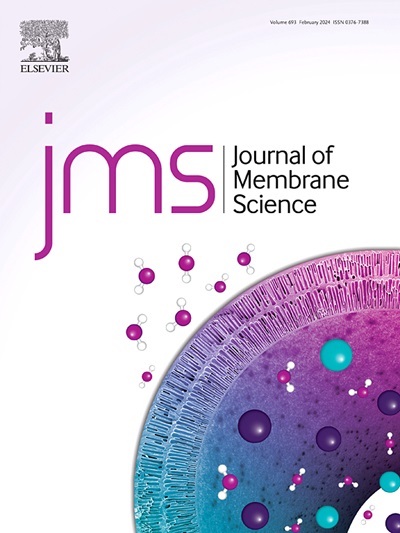MOF ligand engineering boosts molecular-sieving property of mixed-matrix membrane for methanol/methyl acetate azeotropic separation
IF 8.4
1区 工程技术
Q1 ENGINEERING, CHEMICAL
引用次数: 0
Abstract
Pervaporation membrane process is promising for separation of organic-organic azeotropic systems, while a trade-off relationship restricts the performance of widely-studied polymeric membranes. In this work, we proposed a MOF ligand engineering strategy to boost the molecular-sieving property of mixed-matrix membrane (MMM) by synergistically manipulating the channel size, affinity and interfacial morphology. Specially, we designed UiO-66-(NH2)2/polyvinyl alcohol (PVA) mixed-matrix membranes to separate methanol (MeOH)/methyl acetate (MeOAc) azeotropic mixture via pervaporation process. By comparing the incorporation of UiO-66-(NH2)2, UiO-66 and p-phenylenediamine (PPD), the MOF pore size and chemistry were systematically investigated on the influence of microstructures and separation performance of the MMMs. The results demonstrated that the rationally introduced para-position –NH2 groups on the terephthalic acid (BDC) ligands not only finely reduce the MOF pore size of UiO-66 filler, but also improve the interfacial compatibility via hydrogen bonding between UiO-66 and PVA chain, as well as enhance the MeOH affinity in the MMM. The optimized 7.5 wt% UiO-66-(NH2)2/PVA MMM exhibited a total flux of 1554.6 g/m2h and a separation factor of 70.9 in 20 wt% MeOH/MeOAc azeotropic mixture at 30 °C, which is superior to the state-of-the-art membranes. The ligand engineering strategy offers a route for regulating the morphology and molecular transport property of mixed-matrix membranes.

MOF配体工程提高了甲醇/乙酸甲酯共沸分离混合基质膜的分子筛分性能
渗透汽化膜法是分离有机-有机共沸体系的一种很有前途的方法,但聚合物膜的性能受到一种权衡关系的制约。在这项工作中,我们提出了一种MOF配体工程策略,通过协同操纵通道大小、亲和力和界面形态来提高混合基质膜(MMM)的分子筛选性能。特别设计了UiO-66-(NH2)2/聚乙烯醇(PVA)混合基质膜,通过渗透蒸发分离甲醇(MeOH)/醋酸甲酯(MeOAc)共沸混合物。通过对比UiO-66-(NH2)2、UiO-66和对苯二胺(PPD)的掺入,系统研究了MOF孔径和化学性质对MMMs微观结构和分离性能的影响。结果表明,在对苯二甲酸(BDC)配体上合理引入对位-NH2基团,不仅可以很好地减小UiO-66填料的MOF孔径,还可以通过UiO-66与PVA链之间的氢键作用改善其界面相容性,并增强其在MMM中的MeOH亲和力。优化后的7.5 wt% UiO-66-(NH2)2/PVA膜在20 wt% MeOAc /MeOAc共沸混合物中,在30℃下的总通量为1554.6 g/m2h,分离系数为70.9,优于现有膜。配体工程策略为调节混合基质膜的形态和分子运输特性提供了一条途径。
本文章由计算机程序翻译,如有差异,请以英文原文为准。
求助全文
约1分钟内获得全文
求助全文
来源期刊

Journal of Membrane Science
工程技术-高分子科学
CiteScore
17.10
自引率
17.90%
发文量
1031
审稿时长
2.5 months
期刊介绍:
The Journal of Membrane Science is a publication that focuses on membrane systems and is aimed at academic and industrial chemists, chemical engineers, materials scientists, and membranologists. It publishes original research and reviews on various aspects of membrane transport, membrane formation/structure, fouling, module/process design, and processes/applications. The journal primarily focuses on the structure, function, and performance of non-biological membranes but also includes papers that relate to biological membranes. The Journal of Membrane Science publishes Full Text Papers, State-of-the-Art Reviews, Letters to the Editor, and Perspectives.
 求助内容:
求助内容: 应助结果提醒方式:
应助结果提醒方式:


